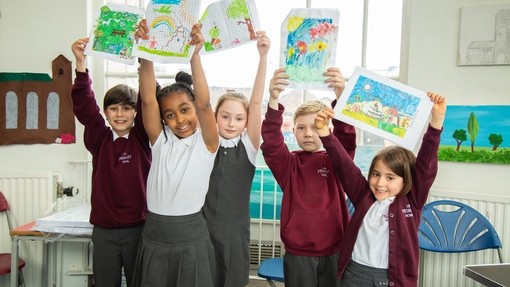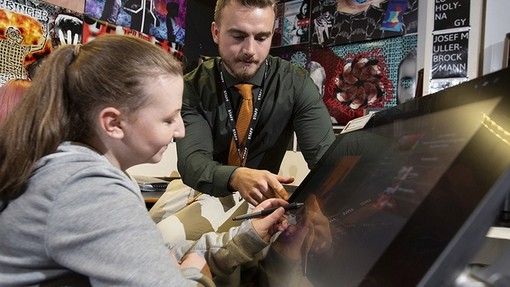
Lucy Palmer-Rimmer, Arts Council England’s Communications Officer for the North, visited Oakhill Primary School, observing how Artsmark keeps history alive for children in the Potteries
There’s nothing unique to Oakhill Primary school on the outside. Tucked away behind a local high school, the 1970’s concrete block seems very familiar to anybody who attended primary school in Britain in the last couple of decades. In contrast, however, as you enter the school through the small reception area you are hit with a mass of colour and creativity, from the history display of multimedia models made of Tudor houses to a brightly coloured welcome wall that runs alongside the corridor towards the classrooms.
I visited Oakhill last term to talk about what I do for the Arts Council and to see their Artsmark work. Despite the sweltering heat and giddy end of term excitement, I was greeted by friendly, smiling polite children all eager to learn about the Arts Council.
Oakhill Primary School is working towards its Artsmark award. Lisa Simpson, the school’s Artsmark lead, spoke passionately to me about the creative work the pupils and staff had been doing. At the beginning of the school year she visited an Artsmark event run by New Vic Theatre, one of the Arts Council’s National Portfolio organisations based locally, where she was put in contact with Artsmark Partner, British Ceramics Biennial. The British Ceramics Biennial support schools across Stoke-on-Trent and Staffordshire on their Artsmark journey by training staff on how to run their own clay schools and teach them basic pottery techniques.
“Creativity is in the blood of the people of Stoke-on-Trent,” Lisa told me. It was important to her that the children learnt about Stoke’s pottery industry which in recent decades has somewhat declined. The people of the Potteries are a proud folk - for centuries the ceramics made from the six towns that make up Stoke-on-Trent have been transported across the world, to tile the floors of some of the finest buildings on the globe or to be used to serve Kings and Queens. Sadly, as the Pot banks have been closed down the identity of the people who live in the city has been chipped away. For many of the children attending Oakhill Primary School, it wouldn’t be uncommon for their great grandparents, grandparents or even parents, to have been employed in the pottery sector. These skills would have been passed down from generation to generation but are now being lost. Lisa felt it was important that her pupils physically engaged with their heritage through exploring clay.
With this idea in mind she ran a training session for her fellow teachers and teaching assistants, passing on the knowledge and skills she had acquired from the British Ceramic Biennial. This was all in preparation for ‘Clay Week’ which would see clay being the focus of all lessons from reception through to Year 6.
Clay was incorporated into learning across the whole school curriculum. Lisa was also the lead for Forest School Learning, so encouraged the pupils to get out into nature to create art from clay and the materials they found around them.
‘Clay Week’ went beyond just equipping children with skills and techniques of how to make clay models and pots. It was a chance for them to learn about subjects in a brand new kinaesthetic way and the sensory experience of physically moulding the clay allowed the children to truly understand the heritage of the place they are from.
I was so inspired to see schools, NPOs and Artsmark Partners coming together to bring such high-quality cultural experiences to young people, keeping the history of their community alive.


